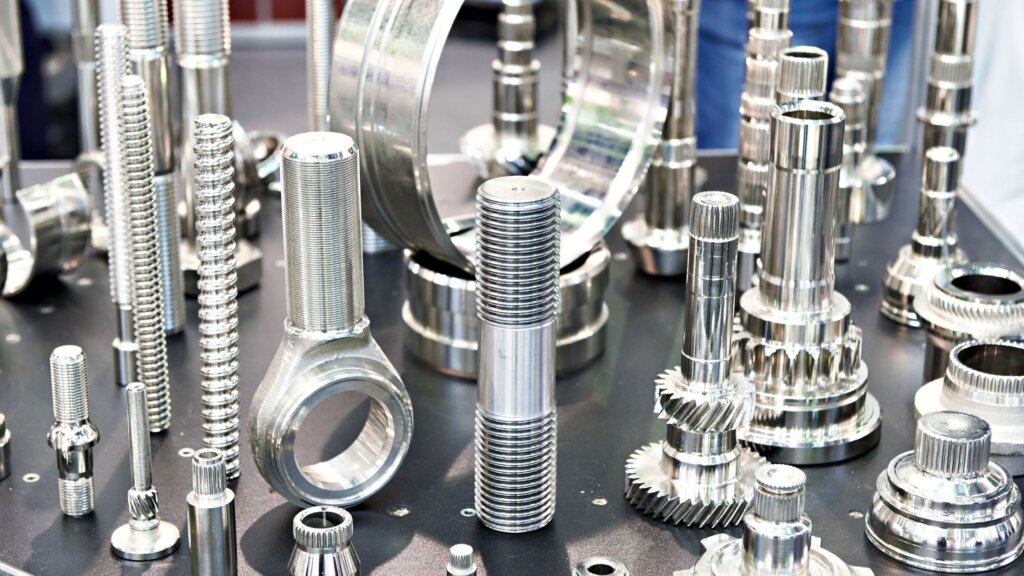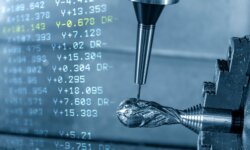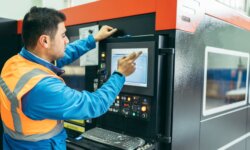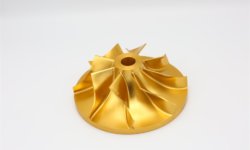CNC machining has become the central pillar of modern manufacturing processes. Most industries rely on this technology to handle the needs of multiple stages of production. From prototyping to mass production, CNC machining can do it all.
However, many professionals wonder how this technology fares against other alternatives. One of the most queried comparisons is the performance of CNC machining vs manual machining process. This article will have a side-by-side overview of these two technologies and see how they perform on every parameter that matters.
What is the Difference Between CNC Machining and Manual Machining?
While Computer Numerical Control (CNC) machining and manual machining do the same thing, the way they do it and the quality of the final product are quite different. Let us have a brief overview of these two technologies before going into the details of each:
What is CNC Machining?
Computer Numerical Control machining, or CNC machining, is the manufacturing process where a cutting tool is controlled by an automated system to remove material from a workpiece. It is a scalable process that can do everything from prototyping to mass production. It was introduced in the middle of the 20th century and the technology pickup up speed with the development of computer science.
What is Manual Machining?
Manual machine, as the name suggests, uses human labor to control the cutting tool and remove material from the workpiece. The cutting tool in this process can be simple or complex, but the relative movement is done by an operator.
CNC Machining vs Manual Machining- Advantages and Disadvantages
Advantages of CNC Machining
CNC machines provide benefits such as:
- CNC machines have a fast production speed.
- Due to the fast production speed, manufacturers can remove bottlenecks from supply and fulfill large-scale manufacturing demands.
- The safety involved in the process is very high since human labor does not have to manually handle the product.
- Due to the precise movement of the cutting tool in as little increments as desired, there is very high precision in the process.
- Since there are no humans operating the cutting tool, there is no possibility of human error.
- The workforce, and thereby the labor costs, are significantly reduced. This manufacturing method only requires one CNC machinist which can oversee the entire CNC operation. In fact, a single CNC machinist can handle multiple CNC machines.
- Since there are no human errors and everything is monitored by automated systems, there are less chances of machine breakdowns leading to reduced maintenance costs.
- It is possible to create highly complex and intricate designs.
- CNC machines take consistency to the next level and all the parts look exactly the same. This is quite desirable in mass production.
- Due to the high precision, research and prototyping sector can visualize what the final product would exactly look like.
- Due to faster production, CNC machining can utilize energy in a better way.
- CNC machines are easier to upgrade, by simply upgrading the software of the machine.
- Since machines are controlled by the software, a single operator can operate multiple machines simultaneously.
- These machines are highly versatile and a single machine shop can work on a large number of materials.
- Due to the reduction of maintenance costs and operating costs, the production costs are decreased. This generates a bigger profit for the manufacturers.
- CNC machining is a reliable process. The machine monitors factors such as temperature and coolant control, so there are fewer breakdowns. In case of breakdowns, many machines can even self-diagnose the issue for faster resolution.
- Complex projects, such as those requiring a multi-axis milling machine, cannot be done properly with manual machines.
Disadvantages of CNC Machining
While CNC machining is the best option when it comes to manufacturing, there can be certain drawbacks to the process as well. These drawbacks are:
- CNC equipment requires high initial investment since the machines are costly. Installation costs are another major factor to consider.
- There is an added stage of computer programming which requires a skilled programmer to create the codes for the compoenents.
- The quality of machine operations are dependent on th operator skill. Therefore, a skilled machinist is required for good outcome.
- While breakdowns are fewer, in case a breakdown manufacturers need to call a highly skilled professional.
- Due to higher automation and a reduction in labor requirements, unemployment is increased.
- After parts are programmed, there is the need of debugging and error detection so that the CNC machines do not crash during operation. The debugging part requires added time and skills.
Advantages of Manual Machining
Manual machining processes have been ongoing since many centuries. They offer benefits such as:
- Manual machining has a low initial investment cost. Therefore, even small machine shops can purchase the equipment without second thoughts.
- There is no need for programming to machine the parts. The machinist can work on the part directly.
- For small projects or one-off orders, the turnaround time is reduced since the machinist does not have to go through programming phase.
- Manual machining can handle customization well since small changes in projects do not require starting from scratch.
- The machinist does not have to be skilled in operating computerized panels.
- In case of breakdowns, machines like manual milling are easy to fix and the cost of repairs is low.
Disadvantages of Manual Machining
Manual machining can have several drawbacks for manufacturers, such as:
- The manufacturing rate of this process is quite slow. What CNC machining can do in a few minutes can require hours of manual machining.
- It cannot handle the modern large scale production requirements and numbers.
- The precision of manual machining is quite precision and incorporates human errors.
- Due to a lack of precision and higher possibility of error, there are more rejections. This leads to higher waste and increased costs.
How to Choose Between CNC Machining vs Manual Machining?
While a CNC machine and a manual machine does the same thing, they are each suitable for different parts and production scales. Here are the applications for each technology:
Applications of CNC Machining
CNC machines are best suited for use cases like:
- A CNC machine is a must have for large scale production of parts. For instance, screw threads require a CNC lathe or CNC mills and using any other process such as manual lathe or manual mill will dramatically slower the production and wouldn’t be worth the cost of the project.
- In the case of prototyping, manufacturers want the prototype to resemble the final parts so they can study the characteristics and defects. For this purpose, CNC lathe, CNC mills, and other CNC equipment are preferred for prototyping tasks.
- For rapid tooling applications, CNC machining is preferred over manual lathes or manual milling machines. This is because rapid tooling works on very hard metals and alloys where manual tooling becomes hard to use due to poor machinability of materials.
- For highly complex parts, manual machines will not get the job done. Multi-axis CNC lathe and CNC milling machines are chosen for such projects. Examples include complex components in the military and aerospace industries.
Applications of Manual Machining
Manual machines can be the better solution for applications like:
- Smaller projects find better utilization of manual milling machine, manual lathe, and other manually operated equipment. This is because for smaller projects, the cost of the project is not big enough to cover the initial investment in a CNC machine.
- For less number of parts such as 1 to 10, manual machines are a better option since there is not enough margin to hire programming teams and create CAD and CAM models of the part.
- For short turnaround time of small manufacturing batches, manual machines are preferred since there is no time for extra steps such as programming.
What is the Cost Difference Between CNC Machining and Manual Machining?
The cost of CNC machining and manual machining services is a wide bracket, depending on a multitude of factors. If you are considering the cost of the machine alone, manual milling machines can start at around $3000, and CNC milling machines can start at around $5000.
Each of them can go up to hundreds of thousands of dollars, with CNC milling being a more expensive option by a major margin.
Similarly, a manual lathe can start at around $1000 while CNC lathes will cost upward of $5000.
If comparing the hourly costs of each, manual machining services can cost around $40 per hour.
On the other hand, CNC machining services can cost somewhere around $80 per hour for a 3-axis machine, and rise up as the requirements become more complex.
While comparing the hourly costs, an important thing to remember is that the CNC machining will have an exponentially higher output than manual machining equipment.
How to Decide If CNC or Manual Machining is Better For Your Needs?
Deciding whether to use CNC machining vs manual machining mainly depends on your requirements and production goals.
If you only want to produce a one-off product for a custom project, manual machining can be a better option. However, for a proper production run or getting high precision parts, CNC machining is the way to go.
If the high initial cost of CNC machines dissuades you from using this technology, opting for 3ERP’s CNC machining can be a great solution. With 3ERP, you get to choose a wide array of options such as multi-axis CNC machines, 3-axis CNC machines, CNC milling machines, CNC lathes, and many other manufacturing options.
All these options come without the high cost of the equipment itself, which provides you with good quality and high precision components minus the added costs of the same.

Conclusion
CNC machines have overtaken most of the market of manual machine tools. Even so, machines like the manual milling machine are preferrable for some operators due to the lack of programming requirements and the ease of setup. However, when the requirement is of mass production, there is nothing better than CNC machining services.
Frequently Asked Questions
Here are the answers to some common questions regarding manual vs CNC machining:
1. Is CNC machining safer than manual machining?
Yes, CNC machining definitely provides a higher safety than manual machines. This is because most of the work in machines like the manual mill are done with human workforce. However, a CNC machine has automation of the cutter, keeping the operators at safe distance.
2. Is CNC machining suitable for a wide range of materials and applications?
Yes, CNC machines is one of the most versatile manufacturing process out there. CNC machining equipment, like the CNC mill, can work on every type of material be it metals, alloys, wood, plastics, ceramics, and even glass. This expands its applications more than other popular manufacturing technology like injection molding.
3. Is CNC more accurate than manual machining?
Yes, CNC machining has a very higher accuracy than manual machines. A CNC machine can provide an accuracy on a microscopic level, which is not possible through manual machines due to human limitations of the latter. This is why CNC machining equipment such as the CNC mill is used where tolerances need to be kept to a minimum.











